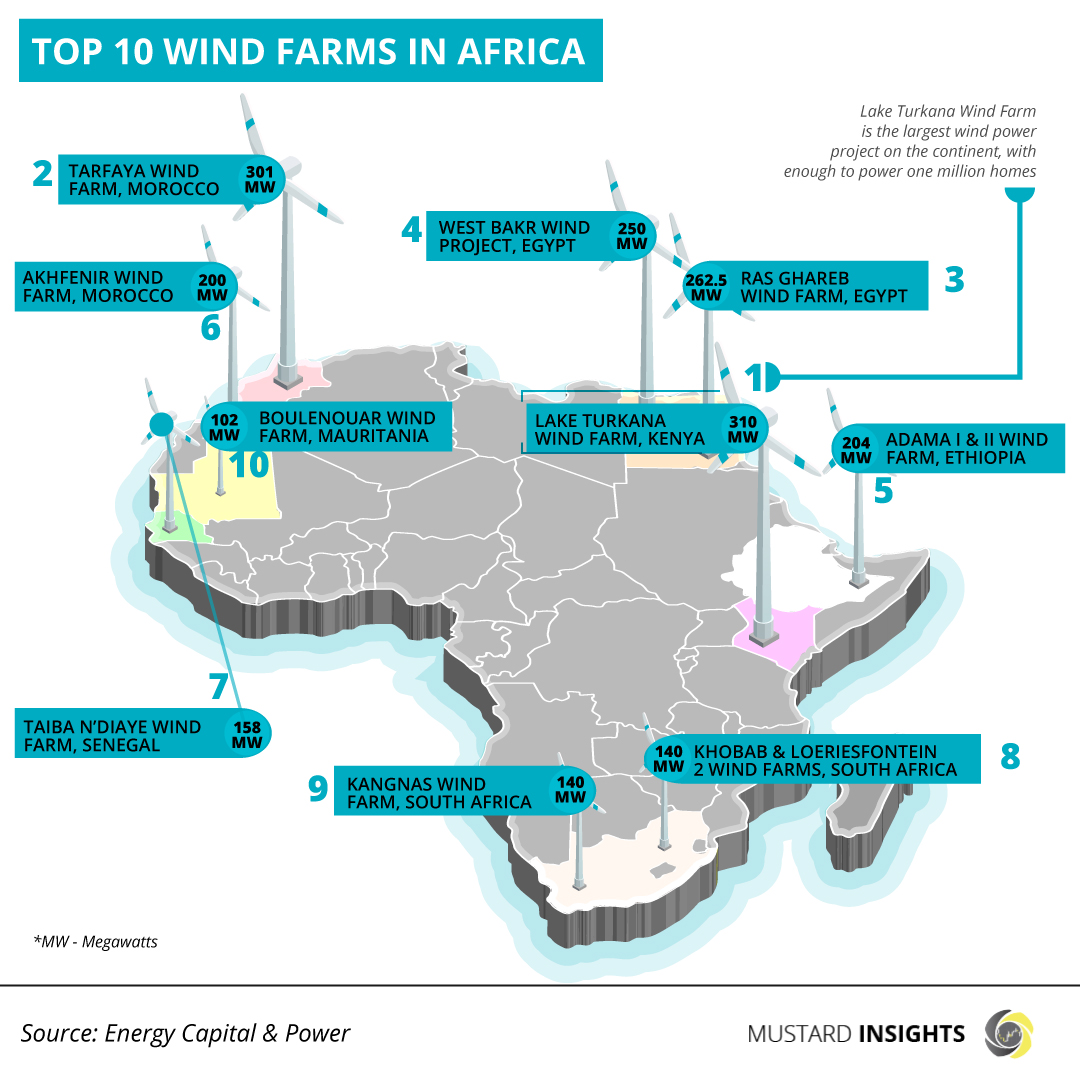Despite enormous potential, Africa continues to struggle with electricity generation through wind power.

For decades, Africa has had issues with electrification. Up to 2022, over half of Africans continue to lack access to electricity, a figure reaching as high as 600 million people. Therefore, it is imperative that African governments strive to increase energy generation numbers. The continent has long relied on fossil fuels for energy, especially for electricity generation. However, the continent is blessed with abundant renewable energy resources.
Africa’s Wind Energy Potential
According to research from PriceWaterhouseCoopers, Africa’s technical wind resource potential is as high as 59,000GW. This describes the amount of electricity that can be generated from wind power if the continent’s wind resources were fully utilized. Numerous parts of the continent have areas with wind speeds exceeding 6 metres per second, the minimum speed needed to efficiently operate wind turbines. Sadly, The Global Wind Council estimates that the continent is only using 0.01% of that 59,000 gigawatts capacity. Only three African countries presently have installed wind power capacity of up to 1 gigawatt, and total current installed capacity is only about 6.5 GW.
Africa possesses a wide distribution of wind power potential geographically. Improvements in wind power technology has raised the possibilities about wind power could be generated. Initial estimations would often place the coastal regions of Northern and Southern Africa as the prime spots for generating wind power. Recently, the World Bank’s International Finance Corporation (IFC), have found that the continent is booming with wind potential, with two-thirds of Africa’s wind potential being in places that possess average wind speeds well exceeding the initial 6 metres per second benchmark.
Countries such as Botswana, Namibia, Nigeria, Chad, Cameroon, Mauritania, Tunisia, and Cote d’Ivoire are all potential wind power generators. None of this countries bar Mauritania presently has a wind power installation exceeding 100 MW. Also, in many of Africa’s wind hotspots, the winds blow strongest in the early evening and the early morning. Both these periods are when electricity demand is typically at its peak, which means wind power can be used as a perfect complement to daytime solar generation.
Existing Major Installations
Egypt, South Africa, and Morocco are Africa’s major wind energy generators. Egypt possesses excellent wind energy resources, with average wind speeds along the Gulf of Suez reaching as high as 10.5 m/s. The country’s Ras Ghareb Wind Farm and West Bakr Wind Farm together generate 512.5 MW of electricity. The largest installation in the country is the Zafarana Wind Farm, built in eight phases between 2000 and 2010, with a combined generation capacity of 550 MW. The 30 MW Phase 1 and 33 MW Phase 2 have been shut down after coming to the end of their twenty-year life span.
Morocco’s Tarfaya Wind Farm is the second largest wind power installation in Africa, with a capacity of 201.6 MW. The country also possesses the 202 MW Aftissat 1 WInd Farm, with the 200 MW Aftissat 2 scheduled to go operational this year. Other major installations in the country are the Akhfenir 1 & 2 Wind Farms with a combined capacity of 202 MW and an added 50 MW going online this year; the 300 MW Boujdour Wind Farm located in the disputed region of Western Sahara, and; the 210 MW Midelt WInd Farm located in Draa-Tafialalet.
While it may not possess installations with the singular generating capacity of the Northern African countries, South Africa has long been a major proponent of wind power. The country possesses twelve wind farms with a capacity of at least a 100 MW, with three of them having installed capacitities of 140 MW each: the Kangnas Wind Power Station in Nama Khoi; Loeriesfontein 2 Wind Farm and its sister project, the Khobab Wind Farm, both in the Northern Cape city of Hantam. Other major projects generating 130-140 MW are the De Aar 2 North Wind Farm; Cookhouse Wind Farm, Amakhala Emoyeni Wind Farm, and Jefferys Bay Wind Farm, all on the Eastern Cape; and the Gouda Wind Farm on the Southern Cape.
Africa’s largest wind power installation is the Lake Turkana Wind Power Station, located in Loiyangalani District of Kenya. The 310 MW-capacity installation can provide enough energy to power one million homes, and comprises of 365 wind turbines. Also, in Eastern Africa is Ethiopia’s Adama I & II Wind Farms, with a combined installed capacity of 204 MW, operational since 2012. West Africa’s largest wind power installation is Senegal’s Taiba N’diaye Wind Farm, with an installed capacity of 158.7 MW, fully operational since 2021.
Issues with Wind Power in Africa
Africa faces many issues with installing wind power on the continent. Unlike solar power, which can be generated and utilized on a small-scale from individuals to communities, wind installations are more expensive and can often only be carried out with the participation of the government. This often necessitates lending, and a lot of Sub-Saharan countries lack the creditworthiness to persuade the private sector to invest.
There is also the issue of conflict and security. Many African governments cannot guarantee security, especially in areas which would be suitable for wind power installations. The interiors of countries such as Sudan, Niger, Chad and the northern parts of Nigeria all possess significant wind power resource potential. These regions also constantly suffer from armed conflicts and insurgencies, posing major security challenges for both constructors and operators.
Another major issue with wind installations is power transmission. Wind energy projects in both onshore and offshore wind will often be situated remotely, far from existing grid infrastructure. This creates a situation of installed but unusable electricity, and transmission lines are often expensive and difficult to install. This issue was seen in the Kenya’s Lake Turkana project: nearly 18 months passed between the completion of the power station and connection to the national grid due to the absence of a high-voltage transmission line.
Opportunities
Given the existence of abundant wind energy potential, wind energy is the second cheapest renewable energy technology after solar. Hence, if the countries which possess significant wind resources can remove the road blocks, there is a steadily available and affordable energy resource for solving the persistent electrification issue. There is also the possibility of electricity exports: countries with significant wind energy resources but smaller energy markets can generate revenue by exporting electricity through inter-connectors and other cross-border transmission infrastructure.
Thoughts?
We won't share your email address. All fields are required.
